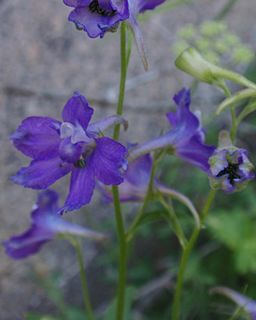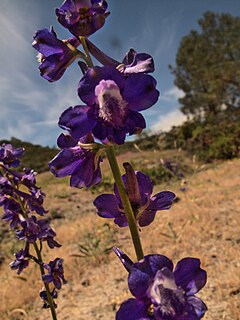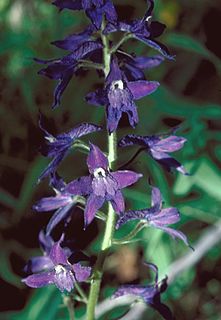
Delphinium patens is a species of larkspur known by the common names zigzag larkspur and spreading larkspur. It is a wildflower limited mainly to California. Though not yet confirmed there, it is expected in Baja California. Plants grow typically 20 to 50 centimeters tall and bear up to 36 flowers each. The stems are mostly hairless, have reddish bases, and bears leaves on the lower half. Each leaf is divided into 3 to 9 lobes. The flower has dark blue sepals, the latter ones reflexed. The spur at the back of the flower is 4 to 8 millimeters long. The cleft at the center of the flower has white or yellowish scattered hairs. The elongated fruit is one or two centimeters long and contains pitted seeds.

Delphinium andersonii is a species of larkspur known as Anderson's larkspur. This wildflower is native to western North America where it can be found in the Great Basin and the Sierra Nevada. This is an erect perennial usually reaching about half a meter in height. It has small leaves on long petioles with the leaf blades divided into long fingerlike lobes. The top of the slender stem is occupied by a cylindrical inflorescence of flowers, each flower two to four centimeters wide with a spur measuring nearly two centimeters in length. The flowers usually have sepals of a brilliant dark blue, with the lower two petals the same color and the upper two petals white. Some individuals have sepals and petals of very light purple or blue to almost white. The anthers are often yellow.

Delphinium californicum is a species of larkspur known as California larkspur. This wildflower is endemic to California, where it is a resident of the chaparral slopes of the San Francisco Bay Area and Central Coast.

Delphinium cardinale is a species of larkspur known by the common names scarlet larkspur and cardinal larkspur. This wildflower is native to California and Baja California, where it grows on coastal, inland, and desert chaparral slopes, such as the Colorado Desert, and the Peninsular and Transverse Ranges. The presence of diterpenoid alkaloids, probably including the highly toxic methyllycaconitine, in the above-ground parts of D. cardinale plants means that they are likely to be toxic.
Delphinium decorum is a species of larkspur known by the common names coastal larkspur and yellowtinge larkspur. This wildflower is endemic to California, where it grows on the slopes of the coastal ranges in the San Francisco Bay Area and north. It grows an erect stem which approaches half a meter in height at maximum. The leaves, which are divided into a number of narrow lobes, are mostly located about the base of the plant. The spindly stem above bears two to twenty widely spaced flowers. Each flower is carried on a pedicel several centimeters long. The five long, flat sepals are extended to give the face of the flower a star shape, and they are usually deep blue to purple. The petals are similar in color, except the top two may be lighter to almost white. The spur is very thin and may be nearly two centimeters long.

Delphinium depauperatum is a species of larkspur known by the common names slim larkspur and dwarf larkspur. This wildflower is native to western North America where it is found in mountain meadows. It grows from a short root and erects a stem usually under 40 centimeters in maximum height. The small leaves are divided into lobes and are usually located about the base of the plant. Toward the top of the stem are flowers on long pedicels, with usually not more than 20 flowers per plant. The flowers generally have deep dark blue sepals which are flat and extended to the sides, and petals which are mainly the same color except for the top two, which may be lighter blue to white. The spur is between one and two centimeters long.
Delphinium gracilentum is a species of larkspur known by the common name pine forest larkspur. It is endemic to California, where it grows throughout the Sierra Nevada. This wildflower is usually around half a meter in maximum height, with leaves growing from the lowest third of the stem. The leaves usually have five lobes. The upper part of the stem is occupied by widely spaced flowers, which each grow at the end of a pedicel a few centimeters long. The flower color may be any shade of blue, or occasionally white or pinkish. The sepals often curl backwards. The spur is usually between 1 and 1.5 centimeters long.

Delphinium gypsophilum is a species of larkspur known by the common name Pinoche Creek larkspur. It is endemic to California, where it grows throughout the central part of the state in woodland and grassland. This wildflower generally reaches between one half and one meter in height. Its pale whitish-green stem is topped with cylindrical inflorescences of up to 30 flowers on short pedicels. The flowers are chalk-white, sometimes drying to a faint blue. Occasional individuals bear pink or light blue flowers. The spur is one to one and a half centimeters long.
Delphinium hutchinsoniae is a rare species of larkspur known by the common names Monterey larkspur and Hutchinson's larkspur. It is endemic to California, where it is known only from Monterey County. This wildflower reaches a meter in height but is usually shorter. The leaves are divided into lobes which are further divided into smaller lobes, and they are mostly located low on the plant. The top of the thin, erect stem is occupied by an inflorescence of not more than ten flowers. Each flower has sepals which are brilliant purple or blue to lavender, two petals which are the same color, and two upper petals which are usually white. The spur is up to two centimeters long and curves down at the tip.

Delphinium nuttallianum is a species of larkspur known by the common names twolobe larkspur and Nuttall's larkspur. It is widely distributed across western North America from California to Alberta. This wildflower has a white to pink erect stem usually not exceeding half a meter in height which may branch several times. Deeply lobed leaves are located mostly about the base of the plant. The inflorescence occupying the top end of the stem has few widely spaced flowers on long pedicels. The sepals are long and curl backwards or fold upon themselves. They may be dark purple to light blue or rarely white. The lower petals are the same color, while the upper are often white. The spur is one or two centimeters long.

Delphinium parryi is a species of larkspur known by the common names San Bernardino larkspur and Parry's larkspur.

Delphinium trolliifolium is a species of larkspur known by the common names poison delphinium, cow poison, and Columbian larkspur. It is native to Washington, Oregon and northern California. This wildflower reaches one half to just over one meter in height. It has large, shiny, deeply lobed leaves. The top half of the stem is an inflorescence of widely spaced flowers on long pedicels, the longest over nine centimeters long. The flowers are usually deep brilliant blue. The upper two petals may be milky white. The spur exceeds two centimeters in length in the largest of the flowers. This plant is toxic as the common names suggest, but most larkspur species are toxic to some degree.

Delphinium bicolour is a species of larkspur known as little larkspur and low larkspur. It is native to northwestern North America from British Columbia to South Dakota, where it grows in mountain forests and foothill scrub and prairie. This is a perennial herb growing from a thickly branching root system. It produces solitary stems to 40 centimeters in height and green with reddish bases. Most of the leaves are low on the stem and grow on short petioles. They are several centimeters long with many rounded lobes. The small inflorescence holds several flowers. The flower has dark purple-blue sepals each about 2 centimeters long and a spur of 1 to 2 centimeters. The plant is poisonous to cattle, less so to sheep, and it is occasionally eaten by various species of wild cervids.
Delphinium inopinum is a species of larkspur known by the common name unexpected larkspur. It is endemic to the Sierra Nevada of California, where it is known mostly from rocky areas in open temperate coniferous forest habitat.

Delphinium polycladon is a species of larkspur known by the common name mountain marsh larkspur. It is native to the High Sierra Nevada and the White and Inyo Mountains of eastern California and far western Nevada, where it grows in wet sites in the talus. It is a perennial herb producing one or more erect stems which easily exceed a meter in height but often remain dwarfed in high-elevation, exposed habitat with thin soils. The leaves are small and mostly located near the base of the plant. The inflorescence is a raceme of up to 35 flowers on long, S-shaped pedicels, often arranged along one side of the stem. The sepals are deep blue to purple, one to two centimeters long, and with a spur up to 2 centimeters in length.

Delphinium uliginosum is a species of larkspur known by the common names swamp larkspur and bog larkspur. It is endemic to California, where it is known from very localized populations in the Inner North Coast Ranges. It grows in chaparral, grassland, and other habitat in the hills, generally on serpentine soils. This is a perennial herb producing a hairless, erect stem up to 70 centimeters tall. It can be identified by its leaves, which are fan-shaped, a characteristic unique among the larkspurs, which generally have palmate leaves with narrow, fingerlike lobes. The inflorescence bears up to 45 flowers, each on an upright pedicel which may exceed 10 centimeters long. The flower is blue with the longest sepals 1.4 centimeters long and a spur about the same length. The fruit is one or two centimeters long.
Delphinium umbraculorum is a species of larkspur known by the common name umbrella larkspur. However, its epithet does not denote an umbrella. Instead, it describes the habitat of this plant, usually shady and cool places. It is often confused with D. parryii which has similar flowers and D. patens which has similar stems and leaves. It is endemic to California, where it grows in the woodlands of the coastal mountain ranges from Monterey to Ventura Counties. It is a perennial herb producing an erect stem 40 to about 80 centimeters tall. The hairless leaves are located at the base of the plant and along the stem as well. The inflorescence bears several flowers with reflexed dark blue sepals and a spur over a centimeter long. The fruit is between 1 and 2 centimeters long.
Delphinium viridescens is a species of flowering plant in the buttercup family known by the common name Wenatchee larkspur. It is endemic to central Washington state in the United States, where it occurs in the Wenatchee Mountains in Chelan and Kittitas Counties.
Delphinium robustum is a species of flowering plant in the buttercup family known by the common names Wahatoya Creek larkspur and robust larkspur. It is native to Colorado and New Mexico in the United States.

Delphinium barbeyi is a species of flowering plant in the buttercup family known by the common names subalpine larkspur, tall larkspur, and Barbey's larkspur. It is native to the interior western United States, where it occurs in the states of Arizona, Colorado, New Mexico, Utah, and Wyoming.













